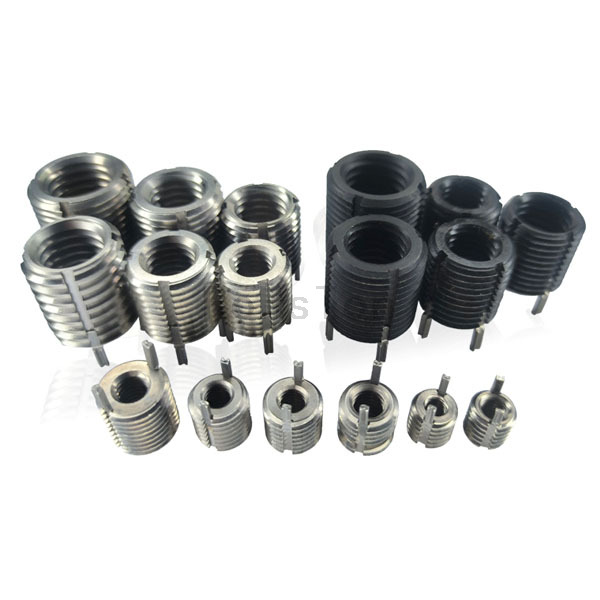In the world of fastening and threaded hole repair, the Keensert stands out as a robust and highly reliable solution, particularly where vibration resistance is paramount. It is a specific type of threaded insert designed to provide a permanent, strong, and wear-resistant internal thread, especially in softer materials or when repairing damaged threads.
Alternative Names:
Key-Locking Insert: This is the most descriptive and widely used alternative term, directly referencing its defining feature.
Key-Lock Threaded Insert
Keysert (often used generically, but sometimes a specific brand name)
High-Strength Threaded Insert
Vibration-Resistant Insert
(Note: "Keensert" itself is often used generically, but originated as a brand name)
Appearance and Structural Features:

A Keensert consists of two primary components:
Threaded Sleeve: This is a precision-machined cylindrical sleeve with external threads (to grip the parent material) and internal threads (to receive the fastener). One end typically has a flanged head.
Locking Keys (Pins): This is the defining feature. Two or four hardened steel pins (keys) are inserted into radial slots machined through the sleeve's wall, near the top (flanged end). During installation, these keys are driven radially outward into the parent material.
Externally: Look for a knurled or smooth cylindrical body with external threads. The flange head often has wrench flats or a hex drive for installation. The locking keys are visible as small, round pins protruding slightly from the sides near the top before installation.
Internally: A continuous, standard (e.g., UNC, UNF, Metric) internal thread runs the length of the sleeve.
Classification:
Keenserts are primarily classified by:
Thread Type & Size: Metric (e.g., M6, M8), Imperial (e.g., 1/4"-20, 5/16"-18).
Length: Various lengths are available to suit different material thicknesses and strength requirements.
Strength: Standard and High-Strength versions exist, differing in material grade and wall thickness.
Head Style: Flanged head (most common) or counterbored head.

Materials:
Keenserts are manufactured from high-strength materials to withstand installation forces, fastener loads, and wear:
Carbon Steel: Most common, often heat-treated to high strength levels (e.g., Grade 8, Grade 9 equivalent).
Alloy Steel: For maximum strength requirements.
Stainless Steel (e.g., 300 series, 400 series): Used for corrosion resistance. Strength is generally lower than carbon/alloy steel equivalents.
Aluminum: Used in specialized applications where weight or non-magnetic properties are critical, offering lower strength.

Surface Treatment:
Surface treatments enhance corrosion resistance, lubricity for installation, and sometimes appearance:
Black Oxide: Most common. Provides mild corrosion resistance and a dark finish.
Zinc Plating: Electroplated zinc offers good corrosion resistance (often with yellow, clear, or black chromate conversion coating). Common for general use.
Cadmium Plating: Excellent corrosion resistance and lubricity, but environmental concerns limit its use (common in aerospace legacy applications).
Dry Film Lubricants (e.g., PTFE): Applied over base plating (like zinc) to reduce friction during installation and fastener use.
Passivation: Used on stainless steel inserts to maximize corrosion resistance by removing free iron from the surface.

Installation Method:
Installing a Keensert requires specific tools (drill, correct tap, installation tool):
Drill: The damaged hole or a new hole is drilled out to a specific, larger diameter using the recommended drill size.
Tap: The drilled hole is tapped with a special STI (Straight Thread Insert) tap. This creates straight (non-tapered) external threads in the parent material to match the Keensert's external threads. Crucially, this tap also cuts recesses where the locking keys will embed.
Insert: The Keensert is screwed into the newly tapped hole using a special installation driver (wrench or screwdriver type) until the flange is seated flush.
Lock: The critical step: Using the installation tool or a separate punch/driver, the hardened steel locking keys are driven radially outwards. They embed firmly into the recesses previously cut by the STI tap in the surrounding parent material. This mechanical lock prevents the insert from rotating or backing out under even severe vibration or torque. The keys are typically designed to shear off flush with the insert body once fully seated.

Typical Applications (Use Scenarios):
Keenserts excel in demanding applications where standard threads fail or helical wire inserts lack sufficient strength/vibration resistance:
Thread Repair: Restoring stripped or damaged threads in critical components (engine blocks, cylinder heads, transmission cases, machinery housings).
Vibration-Prone Environments: Aerospace structures, automotive engines/suspensions, heavy machinery, agricultural equipment, power tools.
Soft Materials: Creating durable, load-bearing threads in materials like aluminum, magnesium, plastic, fiberglass, and wood composites where threads strip easily.
High-Strength Requirements: Applications needing to handle high clamp loads or frequent assembly/disassembly (e.g., mold bases, die sets, structural components).
Upgrading Weak Threads: Replacing threads in castings or thin sections prone to failure.
Maintenance & Repair: Widely used in industrial maintenance shops and rebuild facilities.


Conclusion:
The Keensert, or key-locking insert, is a highly engineered fastening solution prized for its exceptional vibration resistance, strength, and permanence. Its unique design, featuring locking keys driven into the parent material, provides a mechanical interlock unmatched by many other threaded inserts. Whether repairing damaged threads in critical components or creating robust threads in soft materials for high-vibration applications, the Keensert offers a reliable and long-lasting solution across aerospace, automotive, industrial machinery, and countless other demanding sectors.



















